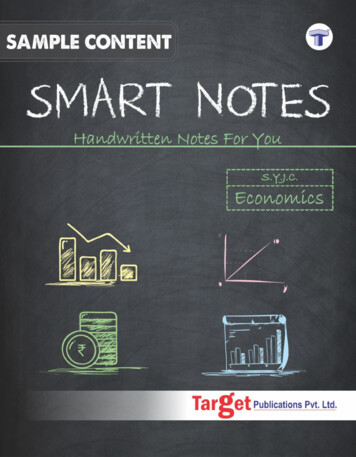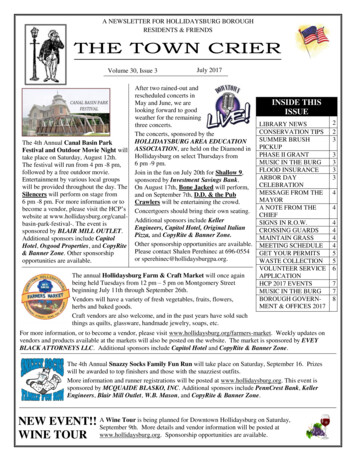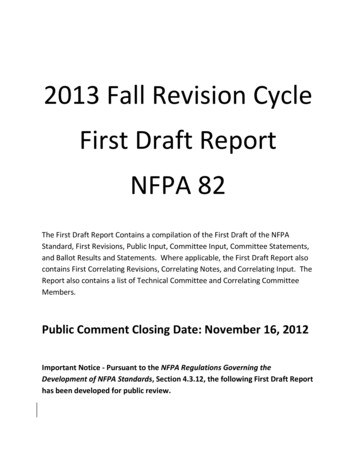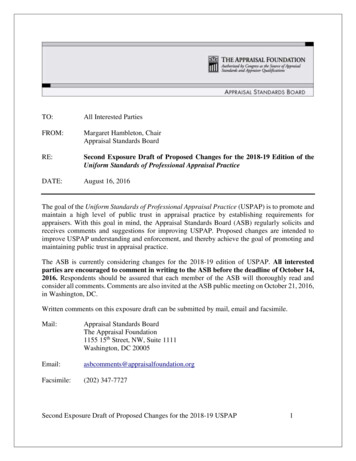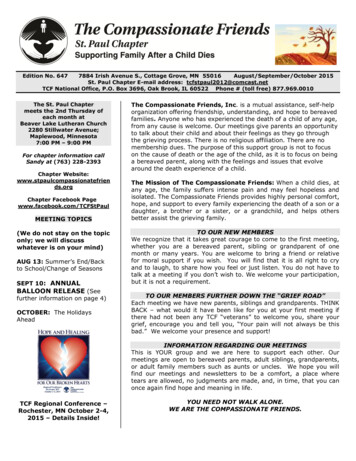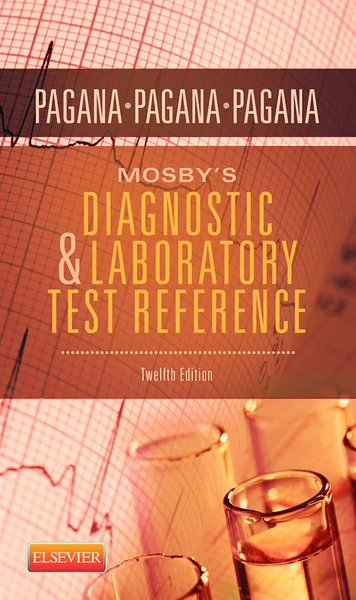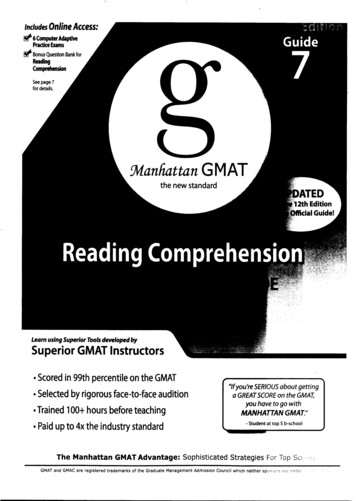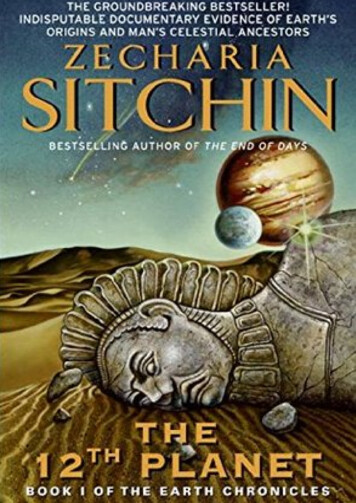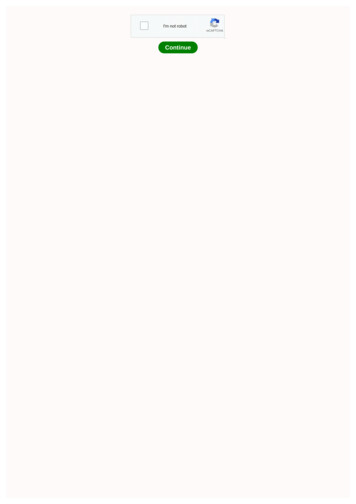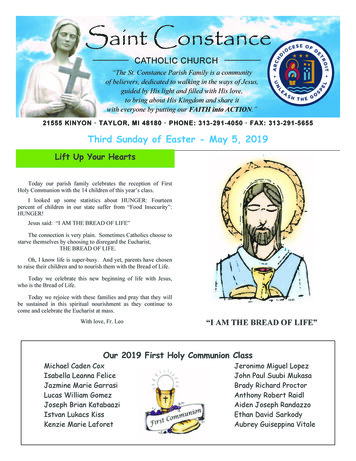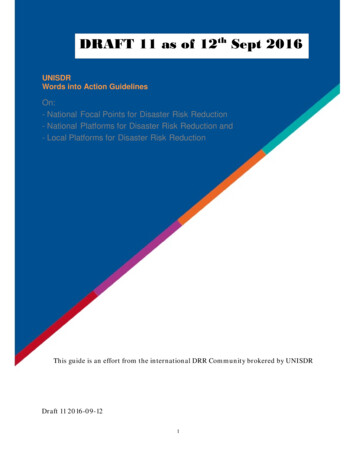
Transcription
DRAFT 11 as of 12th Sept 2016UNISDRWords into Action GuidelinesOn:- National Focal Points for Disaster Risk Reduction- National Platforms for Disaster Risk Reduction and- Local Platforms for Disaster Risk ReductionThis guide is an effort from the international DRR Community brokered by UNISDRDraft 11 2016-09-121
UNISDRWords into ActionGuidelinesNational Focal Points for Disaster Risk ReductionNational Platforms for Disaster Risk Reduction andLocal Platforms for Disaster Risk Reduction2
ContentsUNISDR Words into Action Guidelines .1On: - National Focal Points for Disaster Risk Reduction - National Platforms for Disaster Risk Reduction and Local Platforms for Disaster Risk Reduction .1UNISDR Words into Action Guidelines . 2Preface . 5Acknowledgements . 6Introduction . 7Guideline on National Focal Points, National Platforms and Local Platforms . 8Who is this guide for? . 8Background . 8The Sendai Framework . 9New elements in Sendai Framework . 11Understanding disaster risks . 11All-of-society engagement.12Governance and Accountability .12Request for National Focal Point, a National Platform and Local Platforms .13The Need for National and Local Platforms .13Linkages between National Focal Points, National Platforms and Local Platforms .14Focal Point for DRR definition: .14National Focal Points for DRR .14Characteristics of National Focal Points .14Major Functions of National DRR Focal Points .15National Platform for DRR .16National Platform for DRR definition .16Characteristics of National Platforms.1610 steps to establishing a National Platform .16Major Functions of National Platforms . 17Dynamic National Platforms . 18Multi-Stakeholder Participation . 18Financing .19Inspiring Examples on National level . 20Gambia . 20The Netherlands .21Sweden . 23The Swedish National Platform for Disaster Risk Reduction . 23United Arab Emirates. 25The National Emergency Crisis and Disasters Management Authority . 25Local Platforms . 26Local Platform for DRR definition. 26Characteristics of local platforms . 26Major Functions of Local Platforms . 273
Inspiring Examples on Local level . 28Greater Manchester - Resilience Forum, UK . 28Peru .31Province of Potenza . 33Local Mechanism for Territorial and Community Resilience, Italy . 33Regional and Global Platforms for DRR . 39Characteristics of Regional and Global Platforms for DRR . 39Characteristics of Local, National, Regional and Global Platforms for DRR . 39Regional Platforms . 39Global Platform . 40Specific support from UN and UNISDR . 42Main benefits which Countries gain from UNISDR include: . 42Main benefits which UNISDR gains from National Focal Points and National Platforms for DRR include: . 43UN Plan of Action on Disaster Risk Reduction for Resilience . 44ANNEX 1. 45Key Recommendations from the PREPARATORY EVENT on National Platforms and HFA Focal Points held at theWorld Conference 2015 in Sendai, Japan: . 45ANNEX 2 . 46UN Official Recognition of National Platforms for DRR . 464
PrefaceThe Sendai Framework for Disaster Risk Reduction 2015-2030, adopted by the UN Member States in 2015, isdesigned to reduce existing levels of risk and prevent new risks from emerging. In particular, it aims at substantiallyreducing disaster risk and losses in lives, livelihoods and health and in the economic, physical, social, cultural andenvironmental assets of persons, businesses, communities and countries. The risks addressed by Sendai Frameworkare related to both natural and man-made hazards, small-scale and large-scale, frequent and infrequent, sudden andslow onset disasters.The Sendai Framework recognizes that the State has the primary role in reducing disaster risk. That responsibilityshould however be shared with all stakeholders, including local governments and the private sector.The coordination of disaster risk reduction actions at all levels can be more effective when led and underpinned bynational platforms for disaster risk reduction. In turn, the national platforms should aim to mainstream disaster riskreduction considerations into all aspects of the daily functioning of relevant institutions in a multi-stakeholderapproach.Disasters know no borders. Climate change and rapid urbanization are adding to the mix of existing risks such aspoverty, poor governance, poor land use, exclusion, environmental degradation and human rights issues. Based onscientific evidence and practical knowledge, properly applied disaster risk reduction supports resilience and economicgrowth. Accordingly, this can alleviate societal tensions, limit the likelihood of conflicts and mitigate the impact ofhazards on society.The Sendai Framework includes the guiding principle “Disaster risk reduction requires an all-of-society engagementand partnership. It also requires empowerment and inclusive, accessible and non-discriminatory participation,paying special attention to people disproportionately affected by disasters, especially the poorest.” In that way,embedding disaster risk reduction and making it a part of the very culture of governance and daily work is key to thesuccess of the 2030 Agenda for Sustainable Development and delivering on the Sustainable Development Goals.While the world has made some progress on reducing human losses due to disasters, there is still a long road ahead ofus in avoiding the creation of new risk and reducing existing ones for the generations to come.Robert GlasserSpecial Representative of the United Nations Secretary-General for Disaster Risk Reduction, UNISDR5
AcknowledgementsThis guideline is the product of literature reviews, discussions and contributions from diverse stakeholders, as well asUNISDR-nominated experts appointed specifically for the development of the Words into Action guidelines. UNISDRgratefully acknowledges the following individuals that have been part of the working group:Riyanti Djalante, Research Associate, United Nations University, Institute for Environment and Human Security,Bonn, GermanyNuha Eltinay, Director of Urban Planning and Sustainable Development, Arab Urban Development Institute (AUDI),Saudi ArabiaRouf Mohammad Abdur, Regional Development Coordinator Asia & Pacific, Global Network of Civil SocietyOrganisations for Disaster Reduction (GNDR), BangkokAlhajie Sanneh, Executive Director, National Disaster Management Agency, GambiaLucie Blondel and Andreas Kress, Climate Alliance, BrusselsJulie Calkins, The UK Collaborative on Development Sciences (UKCDS), UKJiuta Korovulavula, Fiji Foundation for the Peoples of the South Pacific International (FSPI), FijiSimon Rogers, Safety Officer at the Peace Boat Disaster Relief Volunteer Center (PBV), Japan CSO Coalition for DRR,JapanIsmail Khan, Program Officer, National Disaster Management Authority (NDMA), Prime Minister Office, Islamabad,PakistanSibusisiwe Ndlovu, Deputy Director, Department of Civil Protection, ZimbabwePedro Ferradas, Risk Reduction and Climate Change Adaptation Programme Manager, Practical Action LatinAmerica, PeruIndira Kulenovic, Head of Regional Community Safety and Resilience Unit, Asia Pacific region, InternationalFederation of Red Cross and Red Crescent Societies, ThailandChang Hun Choe and Mostafa Moghaghegh, International Federation of Red Cross and Red Crescent Societies,GenevaAlessandro Attolico, Executive Director, Provincia Di Potenza, Department of Territorial Planning and CivilProtection, ItalyKathy Oldham, Head of Civil Contingencies & Resilience Unit, Association of Greater Manchester Authorities, UKJon Percival, Police Inspector, Greater Manchester Police, UKÅsa Sjöström, Swedish Meteorological and Hydrological Institute, SwedenHannaSofie Pedersen, Head of unit for landslide and erosion expertise, Swedish Geotechnical Institute, SwedenMikael Granberg, Professor, Karlstad University, SwedenMette Lindahl Olsson, Advisor, Operations Section, Coordination & Operations Department, Swedish CivilContingencies Agency (MSB), SwedenSpecial thanks go to the project leader and coordinator of this guideline, Mette Lindahl Olsson, Swedish secondmentfrom MSB, Swedish Civil Contingencies Agency to UNISDR Regional Office for Europe.UNISDR is also grateful to Craig Duncan, Senior Programme Officer, Dave Paul Zervaas, Programme ManagementOfficer, and to Alex Tsakiridis and Nicole Spence, from the UNISDR Knowledge Management Unit, for theircontribution and support in developing the guide.6
IntroductionThe Sendai Framework for Disaster Risk Reduction charts the global course in disaster risk reduction (DRR) from2015 to 2030. During the consultations and negotiations that led to its finalisation, strong calls were made to developpractical guidance. This would support implementation, ensure engagement and ownership of action by allstakeholders, as well as strengthen accountability in DRR.As a result, paragraph 48 (c) of the Sendai Framework calls upon “the United Nations Office for Disaster RiskReduction (UNISDR), in particular, to support the implementation, follow-up and review of this framework”. Thesupport would be carried out by “generating evidence-based and practical guidance for implementation”. This couldhappen through “close collaboration with States, and through mobilisation of experts; reinforcing a culture ofprevention in relevant stakeholders [ ]”.This Words into Action (WiA) guide aims to support the above process by providing practical guidance on how toimplement the Sendai Framework. The guide also intends to ensure worldwide access to expertise, communities ofpractice, as well as professional networks. The different WiA guides may focus on a specific sector or stakeholdergroup.Mindful that the guides should support the Sendai Framework implementation, they are meant to facilitate access toessential basic thematic information. In addition, they provide clear advice and references that will help to get a goodand thorough grasp of the subject covered. There is also a need to understand the overall context in which the mainsubject is embedded. The guides offer specific advice on the steps suggested to implement a feasible and peoplecentered approach in accordance with the Sendai Framework. Of note, the guides are not meant to be exhaustivehandbooks that will cover each detail in depth. Those who need in-depth information will find pointers to othersources of a more specialised and detailed nature, in addition to the annexes which contain further resources andexamples.In short, the WiA guides are pragmatic roadmaps to programming an effective implementation strategy. This isfacilitated by promoting a good understanding of the main issues, obstacles, solution finding strategies, resourcingand aspects for efficient planning.The overall WiA strategy envisages three main outputs: Guidelines, which really are to-the-point and practical how-to-do handbooks, readily accessible for local andin-the-field use, both printed and online 'How-to-do DRR' packages, maintained online and up-to-date, validated and co-curated by communities onPreventionWeb Information-sharing workspaces and on-line discussion forums, to provide support for communities ofpractice and professional networksTo summarise, the overall objective of the WiA guides is to help engage the DRR community with timely, relevant anduseful data and knowledge. The wealth of cutting edge information and resources is brought together throughsystematised and analytical knowledge management of information. This is generated by valid and recognised sourcesboth online and through inter-agency coordination.7
Guideline on National Focal Points, National Platforms and LocalPlatformsThis document provides guidance on National Focal Points for the Sendai Framework for Disaster Risk Reduction2015-2030 and on the establishment or strengthening of National and Local Platforms for DRR. It also describes thelink between Local, National, Regional and Global Platforms for DRR.To this end, the guide is comprised of the following sections: (i) Introduction to the Guideline and the SendaiFramework for Action; (ii) National Focal Points for DRR; (iii) National Platform for DRR; (iv) Case studies forNational Platforms; (v) Local Platforms; (vi) Case studies for Local Platforms; (vii) Regional and Global Platforms forDRR; (viii) “””Other”””; (ix) Annex.National and Local Platforms for DRR are recognised in the Sendai Framework as key players to achieve acoordinated implementation of DRR strategies, plans and actions. Within the Regional Platforms and the GlobalPlatform for DRR, the National Focal Point and National Platform are seen as important coordinating institutionalparticipants and contributors.It is important to bear in mind that the stakeholders and various actors/sectors at local/sub-national and nationallevels are the main implementers of DRR. This means taking practical action and mapping risks, avoiding thecreation of new risks (for instance in land use planning) and implementing the Sendai framework through legislation,financing programs, policies and programs. The platforms have a crucial role in coordinating strategies, policies,actions, reporting etc. to ensure a more coherent implementation.Learning from previous success in DRR, the Sendai Framework now includes the role of designated National FocalPoints. These Focal Points are responsible for leading the coordinated implementation of the Framework, followingup and reporting on progress. Often the Focal Point ministry or government agency has to perform these duties inaddition to its regular function.Based on previous UNISDR guidelines on national platforms, this guide has been developed by a special workinggroup with skilled persons nominated upon UNISDR request to contribute with their knowledge and practicalexperiences. It has included inputs from a group of government officials from countries with designated NationalFocal Points, National Platforms and Local Platforms for DRR. The working group was also based on a review of theliterature on the progress and challenges in developing the platforms in different countries.Who is this guide for?The guideline is for organisations or personnel, having the responsibility to act as the National Focal Point or to setup, maintain and sustain a national or local platform for DRR. It is also for those who participate in national or localplatforms.National and Local Platforms aim to involve government officials, members of civil society, the private sector and theNGO community, as well as representatives of present international organizations and donors. It is also anticipatedthat the Platforms will include members of the communities that are at risk. With a wide participation from societyreflecting the multi stakeholders approach of DRR.BackgroundThe systematic reduction of the increased impact of disasters is an urgent need. Recognition and commitment amonggovernments worldwide are increasing, in parallel to people affected, lives lost and assets destroyed. Costs, directly orindirectly related to disasters, are expected to increase due to their inter-dependencies, urbanisation and the growingcomplexity of societies. The effective management of the prevention and reduction of risks, however, can reducethem.The Sendai Framework for Disaster Risk Reduction 2015-2030 was agreed by 187 governments at the Third UNWorld Conference on Disaster Risk Reduction in Sendai, Japan. The Framework is a 15-year, voluntary, non-bindingagreement which recognises that the State has the primary role to reduce disaster risk. However, the responsibilityshould be shared with other stakeholders including local governments and the private sector.8
“Each State has the primary responsibility to prevent andreduce disaster risk, including through international,regional, sub regional, transboundary and bilateralcooperation”Disaster risk reduction is a cross-cutting and complex development issue. Each state has the primary responsibility toensure public safety and awareness of risks and to prevent and reduce disaster risks. International, regional, subregional, transboundary and bilateral cooperation can achieve this. In addition, political and legal commitment,public understanding, scientific knowledge, careful development planning and responsible enforcement of policiesand legislation are required. National risk assessment is also needed, as well as disaster loss data, people-centeredearly warning systems, and effective disaster preparedness and response mechanisms. A multi-stakeholder NationalPlatform for DRR can help provide and mobilise knowledge, skills and resources required for mainstreaming DRRinto policies, planning and programs. This also includes initiatives at the local level.In detail, each state is expected to: Decide on a designated National Focal Point for the Sendai Framework with governmental responsibility, asan “entry point” to implement and report on the DRR progressEstablish/strengthen a multi-stakeholder National Platform for DRR to coordinate and develop nationalactivities; provide and mobilise knowledge, skills and resources required for mainstreaming DRR intodevelopment policies, planning and programs; support the local-level implementation of DRR; and be anadvocate of DRR at different levelsThe Sendai FrameworkInternational community and countries all over the world have been working together and have learnt from over 20years of experience in prevention, mitigation, preparedness, response and recovery to natural hazards and disasters inline with the Yokohama Strategy and Plan of Action for a Safer World and the Hyogo Framework for Action (2005–2015): Building the Resilience of Nations and Communities to Disasters (HFA).“The Sendai Framework has a clearer explanation thanHFA of the purpose of managing disaster risks and on therole of coordination horizontal, vertical and with variousstakeholders.”Overall, the HFA provided critical guidance in efforts to reduce disaster risk and has contributed to progress towardsthe achievement of the Millennium Development Goals. Its implementation has, however, highlighted a number ofgaps in addressing underlying disaster risk factors. Furthermore, issues were identified in formulating goals andpriorities for action, in fostering disaster resilience at all levels and in ensuring adequate means of implementation.The gaps indicated a need to develop an action-oriented framework which governments and relevant stakeholderscould implement in a supportive and complementary manner. This would help to identify disaster risks to bemanaged and guide investment to improve resilience.9
“The Sendai Framework focuses on disaster risks while theHFA focused on disaster losses. Now there is a focus onreducing the occurrence of risks and the magnitude ofdisasters”The present framework, the Sendai Framework for Disaster Risk Reduction 2015-2030, has a broader and a morepeople-centered preventive approach to disaster risk. It builds on the understanding that DRR practices, to beefficient and effective, need to be multi-hazard and multi-sectoral, inclusive and accessible.The Sendai Framework also calls for the coherent implementation of the international agreements adopted in 2015 including the Sendai Framework itself, the Addis Ababa Action Agenda for Financing for Development, the 2030Agenda on Sustainable Development, and the Paris Agreement on Climate Change. (Also there is a common UN planof action for UN coordination on DRR for resilience endorsed 1).APPROACHIMPACTRISKS Broader and a more peoplecentered preventive approachto disaster risk Reduce Disaster Risk,losses in lives,livelihoods and healthand in the economic,physical, social, culturaland environmentalassets of persons,businesses,communities andcountries Small-scale and large-scale Frequent and infrequent Sudden and slow-onset Caused by natural or manmade hazards and Other “related”environmental, technologicaland biological hazards Sendai Framework builds onthe understanding thatDisaster Risk Reductionpractices need to be multihazard and multi sectoral,inclusive and accessible inorder to be efficient andeffectiveSendai Framework for Disaster Risk Reduction 2015-2030 contextThe Sendai Framework calls on communities across the globe to prevent and reduce disaster risk in order tosubstantially reduce losses in lives, livelihoods and health and in the various assets of individuals, businesses,communities and countries. In order to do this, the Sendai Framework includes a wide definition of disasters andrisks: Small-scale and large-scale – from single accidents to disasters with local to national/internationalconsequencesFrequent and infrequent – floods, tsunami, earthquake, nuclear disasterSudden and slow-onset disasters – explosions, coastal erosion, desertificationThe framework covers disasters caused by natural or man-made hazards, for instance, landslides, forest fires causedby human activities and industrial accidents. It also includes other “related” environmental, technological andbiological hazards and risks such as contamination of ecosystems, cascading infrastructure failures and public healthUnited Nations Plan of Action on Disaster Risk Reduction for Resilience – Towards a Risk-informed and IntegratedApproach to Sustainable Development, 2016110
risks.The more complex society becomes, the stronger the need for increased understanding and action both verticallybetween local, national, regional and global levels, and horizontally, between communities, local administrations andprivate institutions. The Sendai Framework aims to guide the multi-hazard management of disaster risk indevelopment taking in consideration domino effects, withstanding of basic services and an all hazards approach, atall levels as well as within and across all sectors. In addition, the increased scope of the Framework results in a needfor increased collaboration with government institutions and private sector dealing with health, basic services andcritical infrastructure. There is also a requirement for coherence in disaster risk management policies and practicesacross sectors. Thus sector-and hazard-specific risk assessments, regulations and expertise still need to be furtherdeveloped. Updating hazard databases and risk assessments with climate-related threats and cascading effects isanother necessity identified.New elements in Sendai FrameworkThe Sendai Framework builds on elements, which ensure continuity with the work carried outby countries, municipalities and other stakeholders under the HFA . However, it alsointroduces new elements, such as: A policy shift from managing disasters to preventing and managing risks An understanding that DRR and climate change adaptation are both dep
subject is embedded. The guides offer specific advice on the steps suggested to implement a feasible and people-centered approach in accordance with the Sendai Framework. Of note, the guides are not meant to be exhaustive handbooks that will cover each detail in depth. Those
